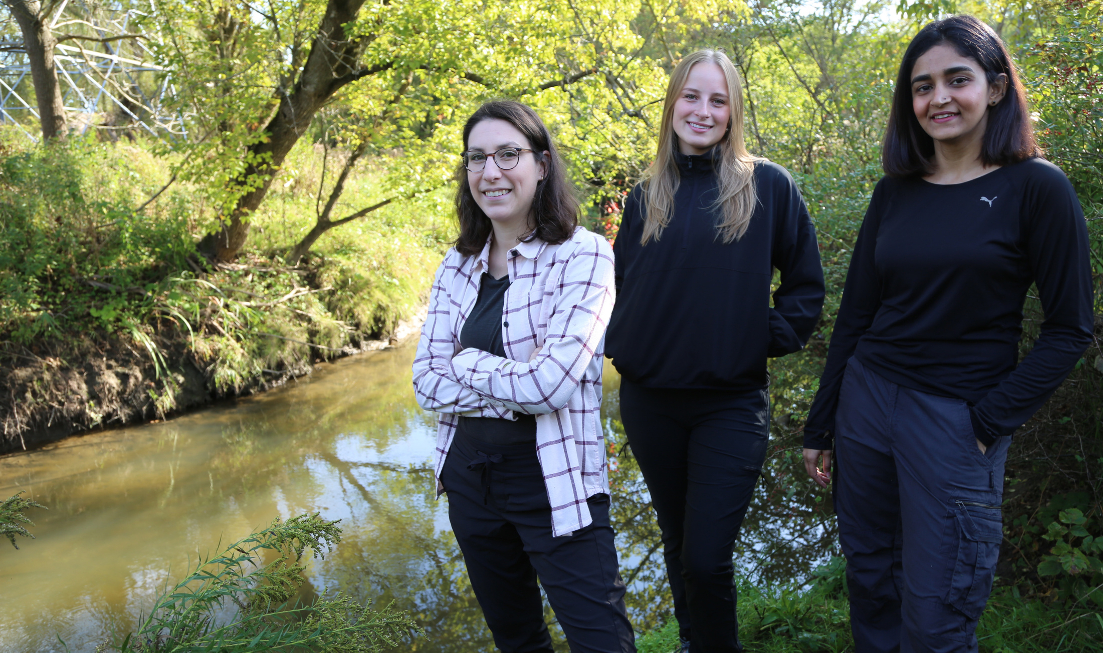A creek runs through it: Students help set up new outdoor teaching and research lab

You could say rivers run in the family for grad students Kate Pearson, centre, and Priyanka Hire, right. They are working with Professor Elli Papangelakis, left, on Mac WELL, a living lab that will monitor the health of the Ancaster Creek aquatic ecosystem in real time.
BY Jay Robb, Faculty of Science
October 21, 2024
Priyanka Hire and Kate Pearson are setting up the latest lab in the School of Earth, Environment & Society — on the the banks of Ancaster Creek.
They’re looking for places to install a network of sensors and stations that’ll make up the new McMaster Watershed and Ecosystems Living Lab (Mac WELL).
The outdoor teaching and research lab will continuously monitor the health of the creek – a vital coldwater habitat that supports aquatic species dependent on cool temperatures to spawn and survive.
The creek runs through much of Hamilton – including the McMaster Forest and West Campus – and into Lake Ontario through the Cootes Paradise wetland behind the university.
A shared vision of a living lab
Mac WELL was officially introduced on Oct. 9 during the 15th annual Woo Water Lecture featuring Ellen Wohl from the department of Geosciences at Colorado State University.
Hire, a PhD candidate, and master’s student Pearson were asked to join Mac WELL by their supervisor Elli Papangelakis, WELL’s founding director.
And Papangelakis, the Fairley Gadsby Research Chair in Fluvial Geomorphology, was nominated by the lab’s scientific advisory committee because of her research expertise.
“It’s a real honour to be leading the lab this early in my career,” says Papangelakis, who joined McMaster as an assistant professor in January 2022 after completing a Master’s in Geography at UBC, a PhD in Civil and Environmental Engineering at the University of Waterloo, and postdoctoral fellowships at Western University, Waterloo and UBC.
The Mac WELL advisory committee is a Who’s Who of environmental science at McMaster.
Joining Papangelakis are Alemu Gonsamo, Canada Research Chair in Remote Sensing of Terrestrial Ecosystems; Mike Waddington, Canada Research Chair in Ecohydrology; Paulin Coulibaly, Science Research Chair in Hydroclimatic Modelling; Altaf Arain, Science Research Chair in Environmental Sustainability and Climate Change; and Sean Carey, Acting Director of the McMaster Centre for Climate Change.
They’d been talking for a couple of years about an outdoor teaching and research lab. McMaster prides itself on being both student-centred and research-focused – the lab could deliver on both fronts.
“We started with off with a pretty a nebulous idea based on our shared research interests,” says Papangelakis. “Over time, it morphed into a concrete idea and vision.”
That vision became a reality when the Ratford Trust provided funding to buy the sensors and stations that will measure real-time changes in water quality, water storage and runoff, weather and climate, stream morphology and remotely sensed land cover and vegetation.
“After years of planning, it’s exciting to see Mac WELL get off the ground,” says Papangelakis. “Our lab will be another way for McMaster to help solve major environmental challenges through research, teaching and citizen science.”
Hands-on learning in real time
Undergraduate and graduate students will play a pivotal role in making that happen, joining through co-ops, courses and capstone projects. In the process, they’ll gain hands-on experience measuring environmental parameters, using state-of-the-art equipment and analyzing datasets.
Papangelakis has reached out to the department of Computing & Software in the Faculty of Engineering for help in figuring out how to manage, store and display the mountain of real-time data that’ll be coming out of the creek.
“I’m not a programmer, but one of the great things about working at a university like McMaster is you have access to colleagues and students who have that expertise and are ready and willing to help.”
Papangelakis sees the potential for many more cross-campus collaborations in the future, including with the departments of Biology and Indigenous Studies.
At the end of her five-year term as director, Papangelakis hopes Mac WELL is fully integrated into courses offered by the Faculty of Science and across the university.
The lab will make it easier to do fieldwork without having to go far afield. She’s also confident it will have collected invaluable data about Ancaster Creek, setting the stage for monitoring what happens during and after the environmental restoration work planned for the creek during the United Nations’ Decade of Restoration.
Like father, like daughter
Hire and Pearson are in their element helping Papangelakis build Mac WELL from the creek bed up. They’re no strangers to studying waterways.
Pearson’s dad is a high school environmental science teacher. She’d often join his field trips to Red Hill Creek and help salmon migrate upstream to their spawning grounds. “That’s when I knew I wanted to explore and understand our natural environment.”
She was in in her third year of undergrad when she reached out to Papangelakis about being a summer research assistant. “I’ve been in the lab ever since.”
Like Pearson, Hire used to join her father on field trips — he’s a professor and fluvial geomorphologist.
“I was introduced to fluvial geomorphology even before I fully understood what it was. I’ve been deeply fascinated by rivers ever since.”
Hire and Pearson can’t wait for more students to get involved. “There’s going to be endless opportunities for hands-on learning,” says Hire. “And at the same time, we’ll be getting important data into the hands of researchers.”
Pearson was involved in creating virtual geohikes as an undergrad, including a four-kilometre stretch of Cootes Paradise. “I would’ve loved to have had even more chances to explore Mac’s backyard while I was an undergrad. Having an accessible research and teaching site located on campus will give students a unique learning experience beyond the classroom.”


